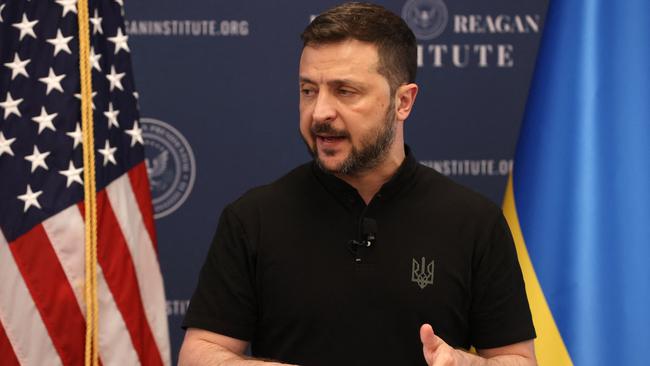NATO allies confront ‘serious gap’ in arms production to counter Russia
The US and Europe are building weapons too slowly to meet Ukraine’s battlefield demands, officials said at the group’s Washington summit.

Senior US and European leaders opened this week’s NATO summit with a pledge to increase the alliance’s investment in military industrial production, while acknowledging that more than two years after Russia invaded Ukraine, the allies are still struggling to produce enough weapons and equipment to help Kyiv win the war.
Even as Russian President Vladimir Putin put his country on a war footing, cranking out tanks and ammunition rounds at an alarming rate, the North Atlantic Treaty Organisation has had limited success in accelerating the output of its own defence industry.
“The reality is that the war in Ukraine has demonstrated not only that the scopes have been too small, and that the production capacity has been delinquent, but it has also demonstrated serious gaps in our interoperability,” NATO Secretary-General Jens Stoltenberg said during a Tuesday event at the US Chamber of Commerce.

Stoltenberg said the allies will sign a new defence industrial pledge this week to increase defence spending, better co-ordinate production among the different countries, and do more to enforce those promises. But he acknowledged that the efforts so far haven’t been sufficient to match the demand from the battlefield in Ukraine.
It remains uncertain whether the kinds of high-level political commitments expected to be announced at the summit in Washington this week will finally translate to signed contracts and increased factory production.
The urgency of making up that shortfall was on display on Monday, when Russia launched an attack on Ukrainian cities, destroying a children’s hospital in Kyiv and killing and injuring dozens of civilians. Russia is expected to ramp up its air assault in the coming months, targeting Ukraine’s energy grid and crucial infrastructure heading into the winter.
So far, the air-defence capabilities the US and NATO allies have been able to pull together for Kyiv have failed to stop such attacks.
While various countries have provided interceptors, those efforts haven’t kept up with the near-daily Russian barrage. The US has given Ukraine one Patriot air-defence battery so far, while the Netherlands has supplied one and Germany two.

President Biden announced Tuesday at the opening of the summit that the US, Germany, the Netherlands, Romania and Italy will provide Ukraine with the equipment for five additional air-defence systems, and in the coming months the US and its partners will also send Kyiv “dozens” of other systems.
The US, Germany and Romania will each donate one Patriot battery; Italy will provide a European-made SAMP/T air-defence system; and Patriot components donated by the Netherlands and other countries will enable the operation of an additional Patriot battery, according to a US official.
Biden also pledged to ensure that Ukraine goes to “the front of the line” for receiving new air-defence interceptors.
In the US, defence companies and the Pentagon now say they were overly optimistic about how quickly they could increase production of critical weapons. Supply-chain kinks and labor shortages meant it will take four years to double output of the US-made Javelin antitank missiles that Ukraine uses widely, twice as long as initially expected.
“We need to do more and we need to do it faster,” said Chris Calio, the chief executive of RTX, which produces the Patriot missile-defence system.
Production is starting to accelerate. US output of 155mm artillery shells has more than doubled to 30,000 a month since the start of the conflict and is expected to almost double again by the end of the summer. US companies have also ramped up production of Patriot interceptors, Himars rocket launchers and the GMLR missiles they fire.
“We are seeing the results as we speak on the battlefield,” said Jake Sullivan, US national-security adviser, during the Chamber of Commerce event.
Rising NATO budgets are being directed at weapons purchases, with almost one-third spent on equipment, double the level a decade ago, according to the International Institute for Strategic Studies, a London-based think tank. But global demand for some weapons systems is running three times available supply, defence executives said.
Even when the funding is available, bureaucratic barriers can hamper more production. Much of the $US45bn in supplemental funding approved in April by the US for Ukraine has yet to go on contract.
“The primary reason for those orders not [to] be secured yet is the contracting capacity and time line of our customers,” said Wahid Nawabi, CEO of AeroVironment, whose Switchblade suicide drones have been deployed widely by Ukraine.

Senior NATO leaders in Washington for the summit acknowledged that it is difficult to increase production. Estonian Defence Minister Hanno Pevkur said Lockheed executives told him they couldn’t fulfil an order for long-range ATACMS missiles before 2028 at the earliest.
Putin can order a sausage factory turned into an arms plant but democracies have planning processes, which can take years, said Pevkur, speaking at the Chamber of Commerce. Executives are trying to adapt, he said. “They need contracts. Without contracts, we will not get production.”
The Wall Street Journal




To join the conversation, please log in. Don't have an account? Register
Join the conversation, you are commenting as Logout